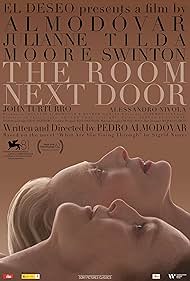Pedro Almodóvar’s first English-language feature
Story
Ingrid and Martha were close friends in their youth, when they worked together at the same magazine. After years of being out of touch, they reunite in an extreme but oddly sweet situation. IMDb editor Arno Kazarian offers quick takes on 12 films he screened at the 2024 New York Film Festival, including Añora and the dangerous and curiously erotic Misericordia.
The answer, alas: it’s disappointing
Featured on The 7PM Project: Episode for September 8, 2024 (2024). I was curious to see what Pedro Almodóvar would do differently in his first non-Spanish-language film, built around two of the most talented actors working today. There are many ways in which "The Next Room" “It lacks what makes Almodóvar’s work so distinctive – the spontaneity, the sense of improvisation, the comic timing, the sparkling ensemble work – but the main flaw of this film, as I see it, is that it is simply overwritten, something that is.” rare in his previous work The script (which he is credited with writing) was adapted from a novel by Sigrid Nunez that I haven’t read, but it feels like large chunks of the dialogue were lifted word for word from it, with much of it being plodding and forced, slowing down and hollowing out the film, where Almodóvar’s work is usually characterized by lapidary dialogue and madcap forward motion, immersing you in the world of the characters with little exposition – as a viewer, you’re just there Even in films dealing with dark themes (such as Pain and Glory or Bad Education), the action and its context play out convincingly some Almodóvar films (even if they are really crazy if you stop to think about them) that appeal to our intuition and empathy and rely only marginally on extended expository narration.
Little is left to our imagination
Here, it’s the opposite: characters talk and explain over and over again, with a few awkward flashbacks to establish context. So while some of the Almodóvar hallmarks are present, notably in the exquisite use of saturated and cleverly coordinated colors and the tastefulness of many of the sets and costumes (here with many lovely still lifes of flowers and fruit), these are reduced to props: they do not serve to tell the story and overwhelm us into accepting the reality of their wildly artificial visual worlds as they do in most of his films. And the computer-generated New York sets look completely artificial and therefore pointless.
“The Next Room,” on the other hand, is all about its plot, and is weaker for it
Almodóvar’s films certainly have plots, often quite convoluted ones (which is part of the fun), but they don’t seem plot-driven, even when they are. With talents like Tilda Swinton and Julianne Moore (plus the estimable John Turturro) in front of the camera, there have to be, and there are, some great moments, often very moving. How could there not be, especially given the plot’s central premise and the way it reinforces and strains a close, long-standing friendship in its final days?
But the verbosity of this script undermines Swinton, in particular
Her astonishing strength lies in her powerful, enigmatic presence and her subtlety. In my unscientific analysis, she says as much dialogue here as in at least the last three or four of her films (the ones I’ve seen, mind you) put together. Consider her stunning performances in another fairly recent film about the fraught relationship between two women, “The Eternal Daughter” (2022), in which she plays, devastatingly, both an elderly mother and her middle-aged daughter.




 32/28
32/28